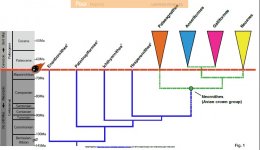Fred Ruhe
Well-known member

Daniel J. Field, Jacob S. Berv, Allison Y. Hsiang, Robert Lanfear, Michael J. Landis & Alex Dornburg, 2019
Timing the extant avian radiation: The rise of modern birds, and the importance of modeling molecular rate variation.
PeerJ Preprints 7:e27521v1
doi: https://doi.org/10.7287/peerj.preprints.27521v1
https://peerj.com/preprints/27521/
NOT PEER-REVIEWED
Abstract
Unravelling the phylogenetic relationships among the major groups of living birds has been described as the greatest outstanding problem in dinosaur systematics. Recent work has identified portions of the avian tree of life that are particularly challenging to reconstruct, perhaps as a result of rapid cladogenesis early in crown bird evolutionary history (specifically, the interval immediately following the end-Cretaceous mass extinction). At face value this hypothesis enjoys support from the crown bird fossil record, which documents the first appearances of most major crown bird lineages in the early Cenozoicâin line with a model of rapid post-extinction niche filling among surviving avian lineages. However, molecular-clock analyses have yielded strikingly variable estimates for the age of crown birds, and conflicting inferences on the impact of the end-Cretaceous mass extinction on the extant bird radiation. This uncertainty has often been ascribed to a patchy avian fossil record, but the possibility of model misspecification in molecular divergence time analyses represents an important and relatively underexplored alternative hypothesis. Here, we highlight the necessity of further developing and using models that account for coordinated variation in rates of molecular evolution across a phylogeny (e.g. molecular early bursts) as a means of assessing support for a rapid post-Cretaceous radiation of crown birds. We discuss how relationships between life-history and substitution rates can mislead divergence time studies that do not account for directional changes in substitution rates over time, and suggest that these effects might have caused some of the variation in existing molecular date estimates for birds. We suggest multiple paths forward that could help resolve this and similar conflicts within other major eukaryotic clades.
Enjoy,
Fred
Timing the extant avian radiation: The rise of modern birds, and the importance of modeling molecular rate variation.
PeerJ Preprints 7:e27521v1
doi: https://doi.org/10.7287/peerj.preprints.27521v1
https://peerj.com/preprints/27521/
NOT PEER-REVIEWED
Abstract
Unravelling the phylogenetic relationships among the major groups of living birds has been described as the greatest outstanding problem in dinosaur systematics. Recent work has identified portions of the avian tree of life that are particularly challenging to reconstruct, perhaps as a result of rapid cladogenesis early in crown bird evolutionary history (specifically, the interval immediately following the end-Cretaceous mass extinction). At face value this hypothesis enjoys support from the crown bird fossil record, which documents the first appearances of most major crown bird lineages in the early Cenozoicâin line with a model of rapid post-extinction niche filling among surviving avian lineages. However, molecular-clock analyses have yielded strikingly variable estimates for the age of crown birds, and conflicting inferences on the impact of the end-Cretaceous mass extinction on the extant bird radiation. This uncertainty has often been ascribed to a patchy avian fossil record, but the possibility of model misspecification in molecular divergence time analyses represents an important and relatively underexplored alternative hypothesis. Here, we highlight the necessity of further developing and using models that account for coordinated variation in rates of molecular evolution across a phylogeny (e.g. molecular early bursts) as a means of assessing support for a rapid post-Cretaceous radiation of crown birds. We discuss how relationships between life-history and substitution rates can mislead divergence time studies that do not account for directional changes in substitution rates over time, and suggest that these effects might have caused some of the variation in existing molecular date estimates for birds. We suggest multiple paths forward that could help resolve this and similar conflicts within other major eukaryotic clades.
Enjoy,
Fred




